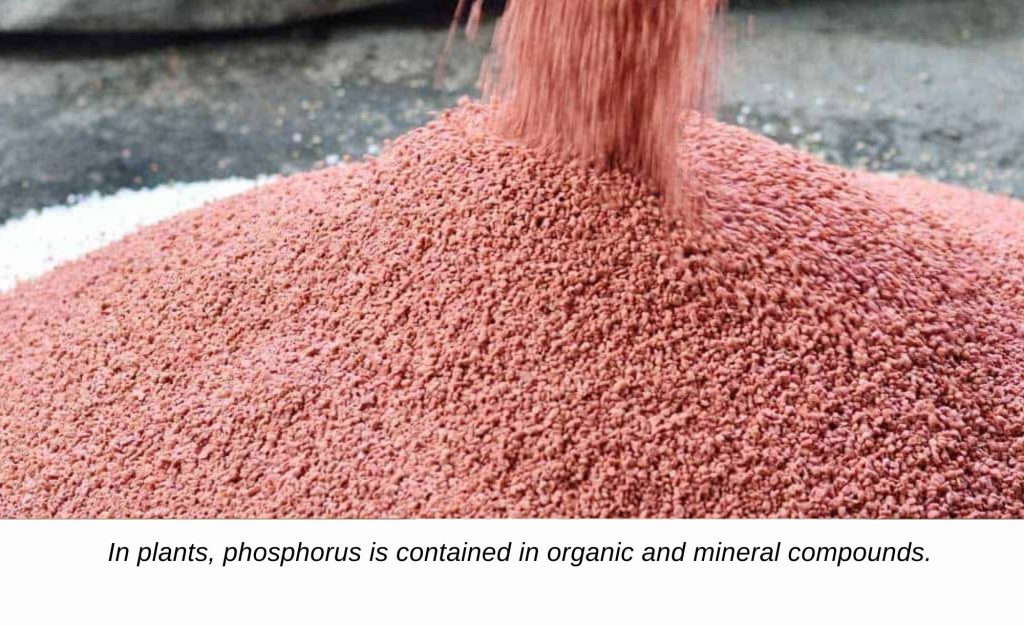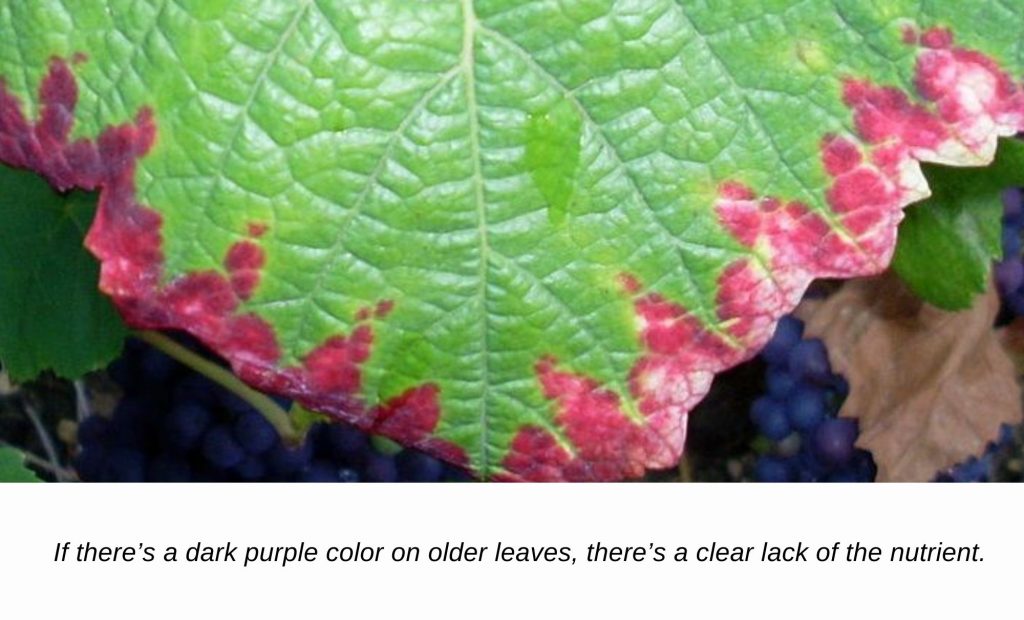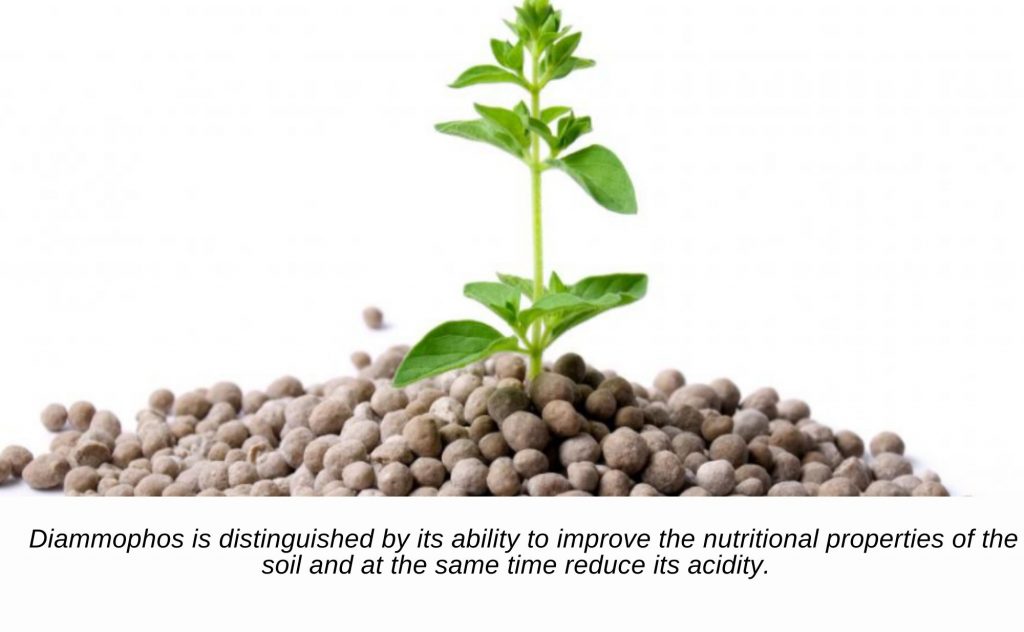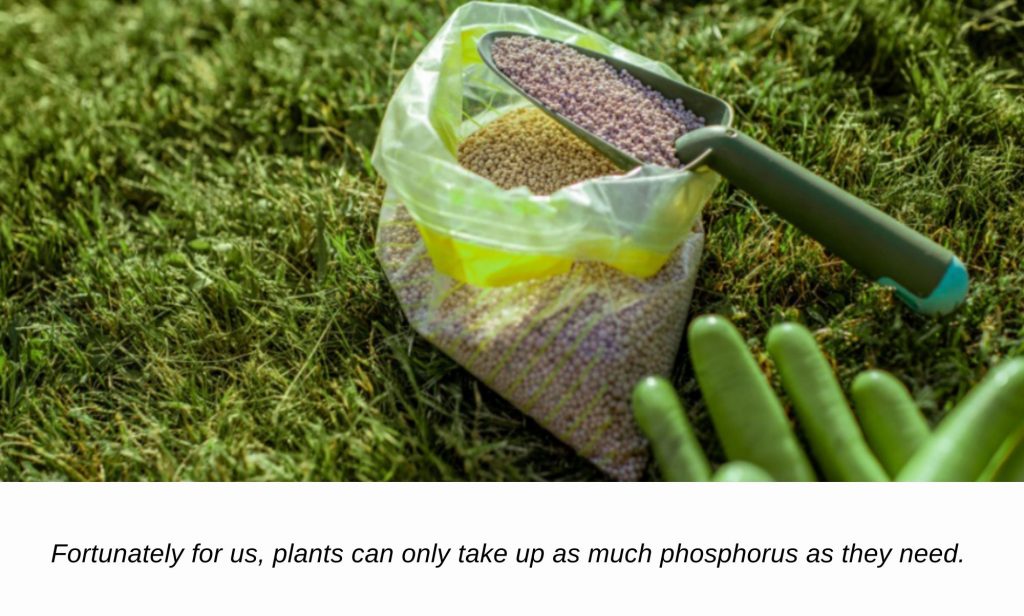Among the chemical elements that make up plants, phosphorus has a special place. Without phosphorus, there is no life. It’s found in every plant cell. Different types of agricultural plants contain varying amounts of this element, and phosphorus, like nitrogen, is much more abundant in grain. The content of phosphorus in plants, soil and fertilizers is usually expressed in terms of its oxide P2O5. In plants, phosphorus is contained in organic and mineral compounds.

In its mineral form, phosphorus comes in the form of salts of phosphoric acid, whose cations are the ions of calcium, magnesium, ammonium, etc. Although their number is small, they are involved in the formation of many phosphorus-containing organic compounds that are vital to plants. Such organic compounds include nucleic acids, nucleoproteins, phosphoproteins, phosphatides, phytins, zucrophosphates, macroergic and other compounds.
Phosphorus in nature
Phosphorus is one of the few elements whose natural compounds consist of a single isotope (P).
In nature, phosphorus occurs only in the form of compounds, the most important of which are the minerals phosphorite and apatite. The main constituent of these minerals is calcium phosphate Saz(PO )2. Phosphorus is a part of protein substances and is abundant in the bones of vertebrates (in the form of calcium phosphate).
Phosphorus content in soils
The surface layer of most soils contains low concentrations of the element – 0.6% (for comparison: nitrogen – 0.14%, potassium – 0.83%).
The element in the soil is in the form of phytin (the main component of organic phosphorus), glycerophosphate, nucleic acid residues and other compounds (organic form) and in the form of poorly soluble salts of phosphoric acids (inorganic form).

Plants take up phosphorus from the soil for their nutrition only in the form of three anions, products of dissociation of phosphoric acid: H2PO4-, HPO4-2 and PO43-. It was revealed that under normal conditions of plant cultivation at low pH, the availability of ions in the series will decrease from left to right.
It should be noted that phosphorus in the soil has weak mobility, which is why plant roots are able to absorb this element only when directly surrounded by phosphorus-containing anions.
Plants absorb phosphorus from soils by 3-5%. Often there is a deficit of plant-available phosphorus, which is justified by the ability of phosphorus anions to bind metals contained in the soil, forming insoluble phosphates that are inaccessible to plants. In turn, the soluble forms of phosphorus are fixed in the soil and then mineralized in the same way.
Importance of phosphorus for plant culture
Phosphorus controls metabolic processes in the plant and is a source of energy. This element is part of the cell nucleus and many substances that play a major role in the life of flora. And in addition, in the mineral form phosphorus is involved in the synthesis of carbohydrates.
Therefore, only with a sufficient amount of phosphorus plants develop properly, grow quickly and bear good fruit. Phosphate fertilizers promote the growth of the plant root system and increase yields, so they are especially important for vegetable, grain, berry and fruit crops.

As you can see, the importance of phosphorus fertilizers is difficult to overestimate. The peculiarity of the use of such fertilizers is that you can not be afraid of “overfeeding” plants with phosphorus. An excess of this element in the soil will not cause harm to green pets, because they assimilate it in such an amount that is necessary for the plant for proper development. Of course this does not mean you can give too much fertiliser, but you do not have to worry if you add more than the prescribed amount.
Influence of phosphorus on plant development
The need of plants for phosphorus varies in different periods of their life. In the initial period after the emergence of seedlings phosphorus is essential, at least in small quantities. As studies have shown, the lack of this element at the beginning of plant growth is not compensated by its application in subsequent periods of growth and development of plants. This is explained by the fact that in the early age the root system of plants develops and stocks up on this nutrient, which is then redistributed among the other organs. Therefore, if you don’t provide sufficient phosphorus nutrition for plants in this period, and apply it later, the yield will be lower even if the application was abundant.
This is why phosphorus is one of the most important macronutrients, which, thanks to its active influence:
- plays a crucial role in energy transfer and plant respiration;
- takes part in transmission of hereditary properties and creation of cell membranes;
- speeds up the transition of plants to the reproductive phase of development;
- has a positive effect on the generative organs of plants;
- helps plants to develop resistance to adverse environmental factors;
- takes part in root formation.
Benefits of phosphorus fertilizers
Phosphorus fertilizers are important and necessary for any soil. Here’s why phosphorus is so important:
- During vegetative mass gain, plants collect solar energy into phosphorus compounds.
- The nutrient serves as a source of energy by entering complex organic compounds and affecting metabolic processes.
- Plants actively absorb the element during flowering and fruiting.
- It slows the aging process of plants and accelerates sprouting.
- It helps form strong fruits.
- Stimulates the growth of a strong root system.
- Increases the intensity of flowering.
- Improves the taste of fruits by increasing the level of starch, fructose, and oils.
- Allows plants to better absorb magnesium.
- Increases resistance to diseases, viruses and parasites.
Phosphorus deficiency and excess
Signs of phosphorus excess
Natural soils with a high content of plant-available phosphorus are rare. But as a result of annual application of phosphorus fertilizers for several years, especially in increased doses, excessive amounts of phosphorus can accumulate. In these cases, annual application of phosphorus fertilizers isn’t necessary, it would be enough to apply them once every 2-3 years. Under the influence of high doses of superphosphate, plants absorb less of some of the micronutrients (zinc, boron, etc.).
Excess of the nutrient leads to accelerated development of plants, as well as yellowing of both individual parts and the whole flower. Plants lose their leaves, acquiring foci of necrosis (necrosis). In addition, an overabundance of phosphorus can provoke shortages of other essential elements like magnesium, copper, cobalt, iron, and zinc. That is, the excess is as dangerous for the plant as its deficiency. This means that it’s very important to keep to the schedule of fertilizer application and adhere to correct dosage, if you want your plants to be healthy and beautiful.
Signs of phosphorus deficiency
In the initial stage of growth, plants are intensively gaining root mass, so this period is characterized by vulnerability to phosphorus deficiency. The shortage of the nutrient can be diagnosed by examining the leaves. If there’s a dark purple color on older leaves or a light blue color on younger leaves, you can conclude there’s a clear lack of the nutrient (leaf content> 0.2%).
If vegetable crops are deficient in phosphorus, it inhibits their growth; the color of leaves changes to dark green with a bluish or purplish tint, stems and leaf petioles become dark purple or purple. The root system is poorly developed, yields are delayed, and resistance to disease is reduced. In potatoes, the starch content of tubers decreases and their taste deteriorates. Phosphorus starvation particularly affects young plants and newly planted seedlings.
In fruit crops, the deficiency manifests itself by poor growth, formation of short thin shoots; apical buds may die off. Old leaves become dull, bluish-green or bronze in color; young leaves become small and narrow. Buds blossom late, flowering is weak, fruits fall off heavily, and the plant begins to shed its leaves early in the fall. The plant’s hardiness is reduced.

Beets and carrots normally require a good supply of phosphorus, especially in the early stages of growth; it also has a noticeable effect on the yield of tomatoes. Black currants and strawberries are sensitive to phosphorus deficiency as well. It’s important to keep in mind that the deficiency may not appear immediately in mature plants: they are able to compensate for it with their own reserves for some time.
Most often the problem occurs in acidic soils with low organic content, so you need to control the level of acidity and deacidify the soil on time if necessary
Phosphorus fertilizer classification
All phosphorus-containing fertilizers are classified into three categories:
The first category is water-soluble fertilizers. This group includes superphosphate, double superphosphate, and superpfos. These fertilizers are great for stimulating root growth and helping to strengthen the roots.
The second category is citrate- and citric acid-soluble fertilizers. This group includes bone meal, precipitated calcium phosphate, and thermophosphate. These fertilizers are especially effective prior to seeding of a wide variety of plants. They are especially good for enriching the soil with phosphorus when there’s deficiency of the nutrient.
The third category is poorly soluble fertilizers. This group includes ammophos, diammophos, phosphorite meal, and vivianite. These fertilizers can interact with nitric and sulfuric acids and don’t interact with weaker acids.
Common phosphorus-containing fertilizers
Water-soluble fertilizers
Superphosphate
This one takes the first place as it’s the first one that comes to mind when it comes to phosphorus fertilizers. It contains a number of substances such as monocalcium phosphate, phosphoric acid, magnesium and sulfur. Visually, superphosphate is a granular powder. It’s used for a wide variety of soil types, often regardless of what kind of crops grow on them. It can be used dry or dissolved, pure or in combination with other fertilizers. Adding superphosphate strengthens the immunity of plants, resulting in increased yield, resistance to a range of diseases and pests, as well as to low temperatures.
Tomatoes are the most responsive to feeding with superphosphate. When it’s applied, their growth is accelerated, flowering is improved, and the setting rate is increased.
Superphosphate can be applied at the time of planting, straight into planting holes. The dose is 0.4 to 0.6 – 0.7oz. per plant. On poor soils and when you need your plants to absorb the nutrient faster, it has to be dissolved in water. It’s advisable to water the soil near tomato bushes during their flowering period with this fertilizer.
The normal application rate is 3.5 oz. per bucket of water, pouring about 17 oz. under each plant.
Double superphosphate
This fertilizer contains about 51% phosphorus in concentrated form. Usually, double superphosphate is used as a fertilizer in autumn. It’s often applied under the soil in small quantities. Per 10 square feet, you need only about 0.3 oz. of the fertilizer. On poor soils, in addition to the autumn application, you can also fertilize in spring, dissolving the fertilizer in water beforehand (0.3 oz. per 33 oz., 33-34 oz. per 10 square feet).
Double superphosphate is one of the most expensive phosphate fertilizers, but the application rates are small, so you can save it. It’s most often used on woody and shrub plants.
The dosage of this fertilizer depends on the plant culture. So, any varieties of currants need 1.5 – 1.9 oz. of fertilizer, raspberries 0.6 – 0.7 oz., gooseberries 1.2 – 1.5 oz., stone fruit crops 2.2 – 2.6 oz. Thus, mature trees of pome and stone cultures over seven years old require about 5.2 – 6.3 oz. of fertilizer, and young (under three years) about 2.2 – 2.6 oz. Vegetable crops are usually fertilized immediately after planting, 0.6 – 0.7 oz. per 10 square feet.
Superfos
This fertilizer comes in granulated form with about 41% phosphorus. It’s especially effective for vegetables and flowers, but can also be used for other types of plants.
Poorly soluble fertilizers
Ammophos
Ammophos comes first here. This fertilizer is obtained by neutralizing orthophosphoric acid with ammonia in the process. As a result, the main component is phosphorus (more than 50%), nitrogen content is minimal (10-12%), but even despite this small amount of nitrogen, phosphorus assimilation increases.
Cucumbers respond best to ammophos fertilization; it increases their resistance to negative environmental factors. Given the absence of chlorine in this fertilizer, which negatively affects cucumbers, they won’t suffer from chlorosis and powdery mildew. In addition, the composition of ammophos has no nitrate compounds, so it’s favorite with gardeners.
They usually use ammophos in the fall and combine it with the recultivation of the soil, but it’s quite effective to use at the time of planting as well. If necessary, this fertilizer can be used in any phase of plant development.
For vegetable crops, they use 0.8 – 0.9 oz. of ammophos per 10 square feet. For large flowers, such as roses or peonies, the dose is 0.8 oz. per 10 square feet. For small flowers (dame’s violets and the like), about 0.2 oz. per 10 square feet. Lawns can be fertilized with 0.5 – 0.6 oz. per 10 square feet.
Diammophos
The second name of this fertilizer is ammonium hydrophosphate. It’s distinguished by its ability to improve the nutritional properties of the soil and at the same time reduce its acidity. The compound contains more than 50% phosphorus, and can be combined well with any organic fertilizer. For example, a mixture of diammophos and bird droppings is considered quite effective, but this compound must be dissolved 12-14 times, infusing it for 4-5 days.
You can use diammophos under any plants. For example, during the planting of potatoes, a teaspoon of this fertilizer can be poured into each hole.
Given the presence of ammonium hydrophosphate, plants can be fertilized both before planting in the ground and during flowering. It’s often used in liquid form and you can both water the plants under the roots and the leaves, that is, as a foliar feeding.
Don’t forget that when applying liquid fertilizers, they must be evenly distributed over the soil surface so that the fertilizer does not accumulate in one place.
Phosphorite meal
This fertilizer looks like a powder of brown or gray color. The advantage of phosphorite meal is that it’s non-hygroscopic, so it can be stored in a variety of places, and it’s odorless. This fertilizer interacts well with mineral acids, resulting in hydrophosphates.
The compound contains up to 32% phosphorus in the form of orthophosphate.
Phosphorite meal is usually used as the main fertilizer and is applied in autumn.
Phosphorite meal can be mixed with other fertilizers. It’s often used to create composts based on peat, manure, and used as a neutralizer for fertilizers characterized by high acidity.
During its storage phosphorite meal doesn’t cake, it’s environmentally clean, absolutely safe and quite cheap. It only has one disadvantage: it’s very dusty when shoveled and dispersed.
Vivianite
This fertilizer is made from iron ore mined in the marshes. It comes in the form of a grayish-blue or blue powder. The compound contains about 30 percent phosphorus, sometimes a little less. Vivianite can be sold pure as well as with peat impurities, the so-called peat vivianite. In this form, it contains from 13 to 21 % phosphorus. By its effect and properties, it’s basically the same as phosphorite meal.
Citrate- and citric acid-soluble fertilizers
Bone meal
This fertilizer is obtained from organic matter by grinding bone tissue of farm animals. It contains up to 62% phosphorus and is environmentally friendly and doesn’t contain any harmful impurities.
Bone meal can be safely used for fertilizing a variety of crops. It’s especially often used to provide phosphorus for potatoes, tomatoes and cucumber plants. House flowers and tropical plants also need to be fertilized with bone meal. Various palms, lianas and ficuses respond to it especially well. For houseplants, you need to dilute three teaspoons of bone meal in 33 oz. of water, this amount is enough for a pot of 2-3 gallons.
Precipitated calcium phosphate
This fertilizer is a whitish-gray or light gray powder. It can contain from 24-26 to 29-31% phosphorus. The compound is suitable for all types of soils and for a wide variety of plants and can be used for both basic doses and for regular fertilizing.
In terms of effectiveness, this fertilizer isn’t inferior even to superphosphate, and when applied to acidic soils, it can be even more effective in terms of normalizing the pH level.
Thermophosphate
Thermophosphate can contain from 13-15 to 29-31% phosphorus, depending on the kind. There are three kinds of thermophosphate, open-hearth slag, calcined phosphate and basic cinder.
The smallest amount of phosphorus – 13-15% – is in basic cinder. It’s produced by processing iron ore. This kind belongs to the category of alkaline fertilizers, and so it’s most effective on soils with high acidity. However, it can be used on any type of soil. The best effect is achieved by thoroughly mixing this fertilizer with the soil.
Open-hearth slag contains much more of the nutrient, up to 16%. This fertilizer is also highly alkaline and is simply indispensable on soils with high acidity.
About twice as much phosphorus (up to 32%) is in calcined phosphate. It’s just as effective as superphosphate on chernozem soils.
Compost phosphorus
As you probably know, plants already contain many nutrients, including phosphorus. The vast majority of plants don’t have that much of it but there are those containing a sufficiently large amount of the nutrient.
For example, the berries of common mountain ash contain up to 1.1% phosphorus, the vegetative mass of bitter wormwood about 1.2%, the fruits of hawthorn about 1.3%, wormwood about 1% and the vegetative mass of creeping thyme contains about 0.8% of the nutrient. Knowing this, you can use the compost of these herbs and fruits to create a good and phosphorus fertilizer completely safe for both plants and the environment.
Main rules for phosphorus fertilizer application
Let’s start with the basic rules for applying phosphorus fertilizers. They are few, simple, and yet, following them allows you to apply fertilizers with the greatest efficiency.
Rule 1
Don’t go overboard with this nutrient. Fortunately for us, plants can only take up as much phosphorus as they need. This doesn’t mean that you can clog the soil with too much of it, but don’t worry about the fact that you have added five grams more than the prescribed amount.
Rule 2
Granular fertilizers mustn’t be spread on the soil surface. It’s in the top layer of soil that phosphorus binds with other minerals and passes into water-insoluble (and therefore inaccessible to plants) forms. So, it’s recommended to apply the fertilizers deeper, in liquid form or in deep holes and directly to the roots.
Rule 3
It’s recommended to apply phosphorus fertilizers in autumn. The nutrient is less soluble in water than other elements and over the long winter it just has time to transform from hard to easy to digest. However, this rule can be neglected if you prefer not to apply fertilizer on a schedule but to feed the plants when necessary.
Rule 4
The effect of organic fertilizers isn’t apparent immediately but 2-3 years after application. So if you practice purely organic farming, have patience.
Rule 5
All superphosphates are not very effective on acidic soils. So add ash (7 oz. per 10 square feet) or lime (17 oz. per 10 square feet) one month before their application.
Conclusion
Phosphorus fertilizers should not be neglected. The nutrient is extremely important for plants and you can’t get a good harvest without it. Decide when it’s most convenient for you to apply the fertilizer and buy the right product in advance. Apply it in the right dosage and your plants will feel great.


